1. Russo GT, Giandalia A, Romeo EL, et al. Fracture risk in type 2 diabetes: current perspectives and gender differences. Int J Endocrinol. 2016; 2016:1615735. PMID:
28044077.

2. Nicodemus KK, Folsom AR. Type 1 and type 2 diabetes and incident hip fractures in postmenopausal women. Diabetes Care. 2001; 24:1192–1197. PMID:
11423501.

3. Schwartz AV, Sellmeyer DE, Ensrud KE, et al. Older women with diabetes have an increased risk of fracture: a prospective study. J Clin Endocrinol Metab. 2001; 86:32–38. PMID:
11231974.

4. Bonds DE, Larson JC, Schwartz AV, et al. Risk of fracture in women with type 2 diabetes: the Women’s Health Initiative Observational Study. J Clin Endocrinol Metab. 2006; 91:3404–3410. PMID:
16804043.

5. Shull RL, Guilkey M, Witty W. Changing the response unit from a single peck to a fixed number of pecks in fixed-interval schedules. J Exp Anal Behav. 1972; 17:193–200. PMID:
16811581.
6. Schwartz AV, Sellmeyer DE, Strotmeyer ES, et al. Diabetes and bone loss at the hip in older black and white adults. J Bone Miner Res. 2005; 20:596–603. PMID:
15765178.

7. Melton LJ 3rd, Riggs BL, Leibson CL, et al. A bone structural basis for fracture risk in diabetes. J Clin Endocrinol Metab. 2008; 93:4804–4809. PMID:
18796521.

8. Shanbhogue VV, Finkelstein JS, Bouxsein ML, et al. Association between insulin resistance and bone structure in nondiabetic postmenopausal women. J Clin Endocrinol Metab. 2016; 101:3114–3122. PMID:
27243136.

9. Srikanthan P, Crandall CJ, Miller-Martinez D, et al. Insulin resistance and bone strength: findings from the study of midlife in the United States. J Bone Miner Res. 2014; 29:796–803. PMID:
23983216.

10. Shim JS, Song BM, Lee JH, et al. Cardiovascular and metabolic diseases etiology research center (CMERC) cohort: study protocol and results of the first 3 years of enrollment. Epidemiol Health. 2017; 39:e2017016. PMID:
28395401.

11. Chun MY. Validity and reliability of Korean version of international physical activity questionnaire short form in the elderly. Korean J Fam Med. 2012; 33:144–151. PMID:
22787536.

12. Matthews DR, Hosker JP, Rudenski AS, et al. Homeostasis model assessment: insulin resistance and beta-cell function from fasting plasma glucose and insulin concentrations in man. Diabetologia. 1985; 28:412–419. PMID:
3899825.
13. Levey AS, Stevens LA, Schmid CH, et al. A new equation to estimate glomerular filtration rate. Ann Intern Med. 2009; 150:604–612. PMID:
19414839.

14. Danielson ME, Beck TJ, Karlamangla AS, et al. A comparison of DXA and CT based methods for estimating the strength of the femoral neck in post-menopausal women. Osteoporos Int. 2013; 24:1379–1388. PMID:
22810918.

15. Khoo BC, Brown K, Zhu K, et al. Effects of the assessment of 4 determinants of structural geometry on QCT- and DXA-derived hip structural analysis measurements in elderly women. J Clin Densitom. 2014; 17:38–46. PMID:
23578719.

16. Lee SJ, Kim KM, Brown JK, et al. Negative impact of aromatase inhibitors on proximal femoral bone mass and geometry in postmenopausal women with breast cancer. Calcif Tissue Int. 2015; 97:551–559. PMID:
26232103.

17. Cuzick J. A Wilcoxon-type test for trend. Stat Med. 1985; 4:87–90. PMID:
3992076.

18. Strotmeyer ES, Cauley JA, Schwartz AV, et al. Diabetes is associated independently of body composition with BMD and bone volume in older white and black men and women: the Health, Aging, and Body Composition Study. J Bone Miner Res. 2004; 19:1084–1091. PMID:
15176990.

19. Napoli N, Chandran M, Pierroz DD, et al. Mechanisms of diabetes mellitus-induced bone fragility. Nat Rev Endocrinol. 2017; 13:208–219. PMID:
27658727.

20. Reid IR, Evans MC, Cooper GJ, et al. Circulating insulin levels are related to bone density in normal postmenopausal women. Am J Physiol. 1993; 265:E655–E659. PMID:
8238341.

21. Verroken C, Zmierczak HG, Goemaere S, et al. Insulin resistance is associated with smaller cortical bone size in nondiabetic men at the age of peak bone mass. J Clin Endocrinol Metab. 2017; 102:1807–1815. PMID:
28001453.

22. Petit MA, Paudel ML, Taylor BC, et al. Bone mass and strength in older men with type 2 diabetes: the Osteoporotic Fractures in Men Study. J Bone Miner Res. 2010; 25:285–291. PMID:
19594301.

23. Gilsanz V, Chalfant J, Mo AO, et al. Reciprocal relations of subcutaneous and visceral fat to bone structure and strength. J Clin Endocrinol Metab. 2009; 94:3387–3393. PMID:
19531595.

24. Farr JN, Chen Z, Lisse JR, et al. Relationship of total body fat mass to weight-bearing bone volumetric density, geometry, and strength in young girls. Bone. 2010; 46:977–984. PMID:
20060079.

25. Bredella MA, Lin E, Gerweck AV, et al. Determinants of bone microarchitecture and mechanical properties in obese men. J Clin Endocrinol Metab. 2012; 97:4115–4122. PMID:
22933540.

26. Frost HM. Bone “mass” and the “mechanostat”: a proposal. Anat Rec. 1987; 219:1–9. PMID:
3688455.

27. Lebrasseur NK, Achenbach SJ, Melton LJ 3rd, et al. Skeletal muscle mass is associated with bone geometry and microstructure and serum insulin-like growth factor binding protein-2 levels in adult women and men. J Bone Miner Res. 2012; 27:2159–2169. PMID:
22623219.

28. Lee S, Kim Y, White DA, et al. Relationships between insulin sensitivity, skeletal muscle mass and muscle quality in obese adolescent boys. Eur J Clin Nutr. 2012; 66:1366–1368. PMID:
23073260.

29. Ferron M, Wei J, Yoshizawa T, et al. Insulin signaling in osteoblasts integrates bone remodeling and energy metabolism. Cell. 2010; 142:296–308. PMID:
20655470.

30. Hahn TJ, Westbrook SL, Sullivan TL, et al. Glucose transport in osteoblast-enriched bone explants: characterization and insulin regulation. J Bone Miner Res. 1988; 3:359–365. PMID:
2463740.

31. Karlsson MK, Weigall SJ, Duan Y, et al. Bone size and volumetric density in women with anorexia nervosa receiving estrogen replacement therapy and in women recovered from anorexia nervosa. J Clin Endocrinol Metab. 2000; 85:3177–3182. PMID:
10999805.

32. Szulc P, Seeman E, Duboeuf F, et al. Bone fragility: failure of periosteal apposition to compensate for increased endocortical resorption in postmenopausal women. J Bone Miner Res. 2006; 21:1856–1863. PMID:
17002580.

33. Kindler JM, Pollock NK, Laing EM, et al. Insulin resistance negatively influences the muscle-dependent IGF-1-bone mass relationship in premenarcheal girls. J Clin Endocrinol Metab. 2016; 101:199–205. PMID:
26574958.

34. Kindler JM, Pollock NK, Laing EM, et al. Insulin resistance and the IGF-I-cortical bone relationship in children ages 9 to 13 years. J Bone Miner Res. 2017; 32:1537–1545. PMID:
28300329.

35. Yakar S, Canalis E, Sun H, et al. Serum IGF-1 determines skeletal strength by regulating subperiosteal expansion and trait interactions. J Bone Miner Res. 2009; 24:1481–1492. PMID:
19257833.

36. Davis KA, Burghardt AJ, Link TM, et al. The effects of geometric and threshold definitions on cortical bone metrics assessed by in vivo high-resolution peripheral quantitative computed tomography. Calcif Tissue Int. 2007; 81:364–371. PMID:
17952361.

37. Kang JH. Association of serum osteocalcin with insulin resistance and coronary atherosclerosis. J Bone Metab. 2016; 23:183–190. PMID:
27965939.

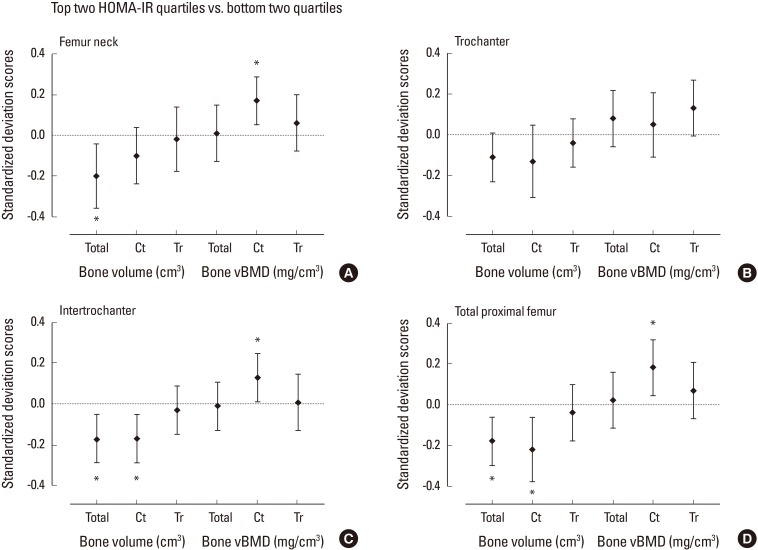
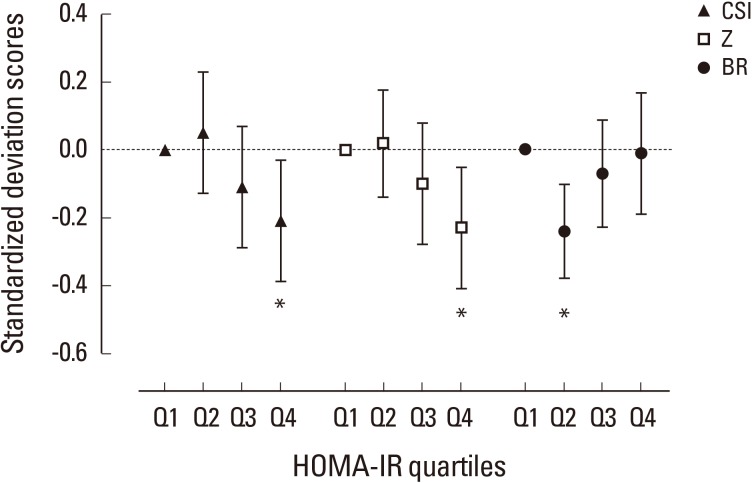
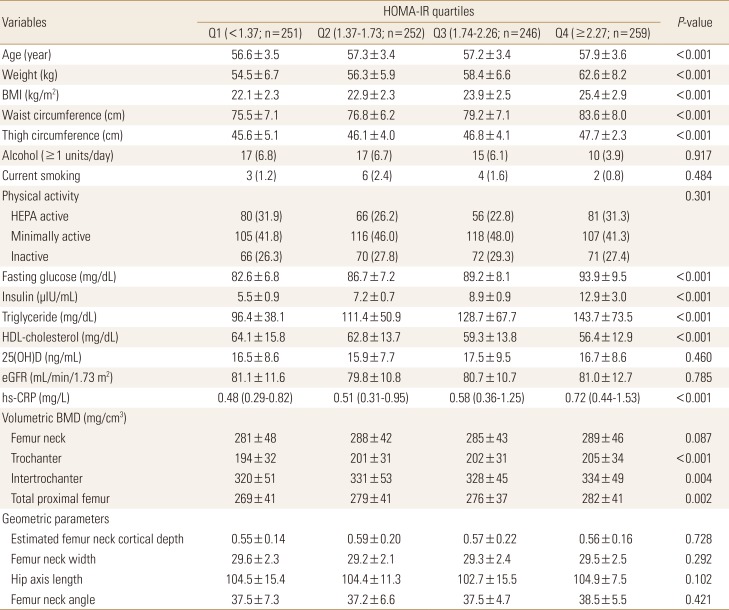
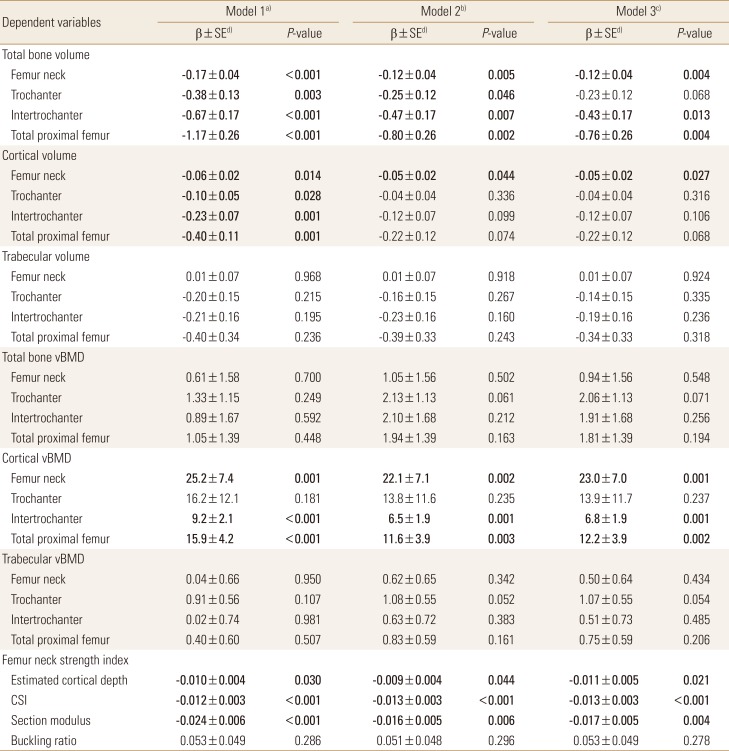




 PDF
PDF ePub
ePub Citation
Citation Print
Print


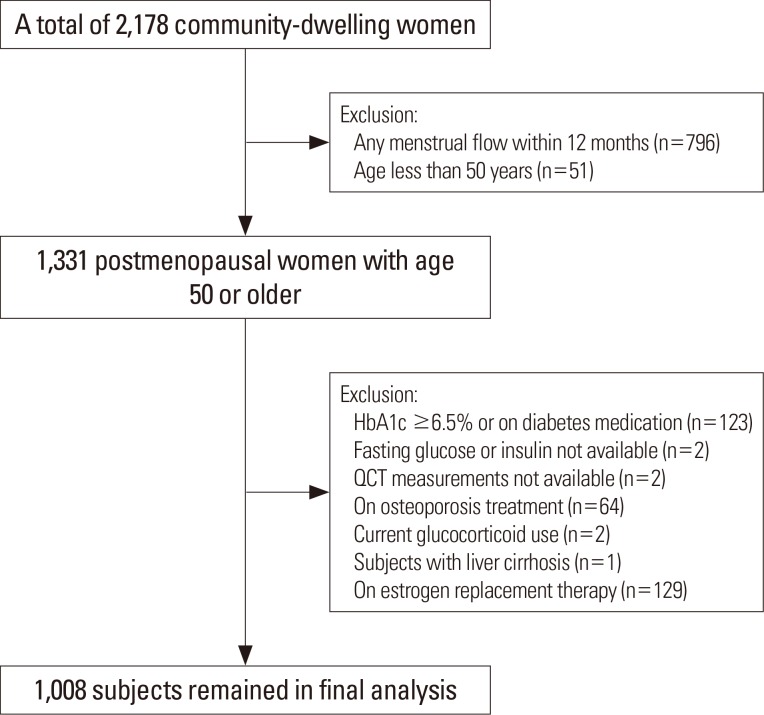
 XML Download
XML Download